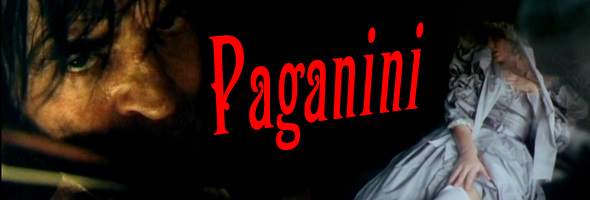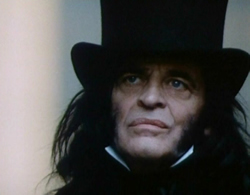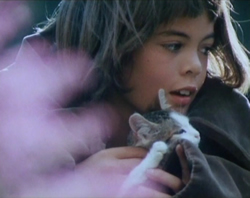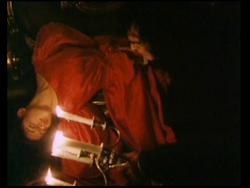

Color, 1989, 84 mins. 38 secs. / 94 mins. 13 secs.
Directed by Klaus Kinski
Starring Klaus Kinski, Debora Caprioglio, Nikolai Kinski, Dalila Di Lazzaro, Eva Grimaldi, Marcel Marceau, Feodor Chaliapin
Vinegar Syndrome (Blu-ray) (US R0 HD) / WS (1.66:1) (16:9), Mya (DVD) (US R0 NTSC), X-Rated Kult (Germany R2 PAL)
One of the most  notorious maniacs in cinema history, Klaus Kinski earned a terrible
notorious maniacs in cinema history, Klaus Kinski earned a terrible  reputation for his difficult behavior on sets that only hinted at his heinous nature out in the world. He was also a mesmerizing screen presence with the right material, particularly when paired up with director Werner Herzog. However, when Herzog turned down Kinski's dream project of a biopic about legendary violinist Niccolo Paganini (who was rumored to have made a pact with the devil for his almost supernatural skills with the musical instrument), Kinski himself stepped into the director's chair. This was his first and only time in this position, not counting some uncredited work helping with the troubled production of Nosferatu in Venice, and it proved to be a more problematic film than anyone could have anticipated. It was barely released outside of Europe in 1989 and proved to be his final film, as he passed away two years later.
reputation for his difficult behavior on sets that only hinted at his heinous nature out in the world. He was also a mesmerizing screen presence with the right material, particularly when paired up with director Werner Herzog. However, when Herzog turned down Kinski's dream project of a biopic about legendary violinist Niccolo Paganini (who was rumored to have made a pact with the devil for his almost supernatural skills with the musical instrument), Kinski himself stepped into the director's chair. This was his first and only time in this position, not counting some uncredited work helping with the troubled production of Nosferatu in Venice, and it proved to be a more problematic film than anyone could have anticipated. It was barely released outside of Europe in 1989 and proved to be his final film, as he passed away two years later.
Ostensibly there are other actors in this film, but 95% of it is focused entirely on Kinski (with jet-black hair, sideburns and eyebrows) as he portrays Paganini in his final years, alternating between his deathbed throes and his glory days on the stage in which his playing would induce any woman within earshot to frenzies of physical ecstasy. There's very little dialogue and almost no plot as he moves from one female conquest to another (including Napoleon's little sis) and serves as a very weird role model for his son (with Kinski's real-lief wife and son at the time essaying the same family relations in the film). Along the way it's fun to spot the filmmakers who obviously inspired this free-associative montage movie, ranging from Werner Herzog (obviously) to Ken Russell (especially Lisztomania) and definitely Walerian Borowczyk (especially  the powdery, candlelit softcore sex scenes) and Andzej Zulawski, who worked with Kinski on L'important c'est d'aimer.
the powdery, candlelit softcore sex scenes) and Andzej Zulawski, who worked with Kinski on L'important c'est d'aimer.
Critically panned at the time and given a final edit without Kinski's involvement for Italian and French audiences, Paganini was a serious labor of love for its creator who was distressed at its reception. It's certainly an astonishing and wildly self-indulgent film to watch; if you don't know what you're getting into, the first ten minutes will be enough for many viewers to lunge for the stop button. However, it's also a feverish, wholly unique ego trip on film in a way only a true madman could pull off, and love it or hate it, this stands as a fascinating testament to one  man's determination to get his vision on film no matter what. Hilariously, the film's much-publicized creation led to an Italian horror cash-in the same year, Luigi Cozzi's Paganini Horror, which also suffered a lousy theatrical fate and didn't snag much international distribution.
man's determination to get his vision on film no matter what. Hilariously, the film's much-publicized creation led to an Italian horror cash-in the same year, Luigi Cozzi's Paganini Horror, which also suffered a lousy theatrical fate and didn't snag much international distribution.
Long circulated on the bootleg video circuit throughout the '90s, Paganini was eventually released on DVD in Germany in one of this oversized clamshell boxes by X-Rated Kult, who paired up the theatrical cut with a workprint of the "version originale," which is basically the only surviving version of Kinski's original cut with a music mix but some ragged edits and filmic debris throughout. Those options are carried over to the film's first American video release in any format courtesy of Mya's DVD from 2011 which presents the theatrical cut on disc one.  Audio options are English, Italian, and French with no subtitle options, but given the fact that a very small percentage of the film has any dialogue (and most of that is voiceover at that), it doesn't matter much. The biggest extra here is a pretty amazing 54-minute backstage reel of video footage showing Kinski at work on the film. Cavorting on the beach, shouting at the actors, and coaxing his actresses through some of their lustier scenes, he's always wild to watch in documentaries and once again glues your eyes to the screen even when he's completely off his rocker. A maniacal Cannes press conference features Kinski shrieking at the reporters in German (no subs, but you'll get the idea), followed by a quick photo opp. Image quality for the
Audio options are English, Italian, and French with no subtitle options, but given the fact that a very small percentage of the film has any dialogue (and most of that is voiceover at that), it doesn't matter much. The biggest extra here is a pretty amazing 54-minute backstage reel of video footage showing Kinski at work on the film. Cavorting on the beach, shouting at the actors, and coaxing his actresses through some of their lustier scenes, he's always wild to watch in documentaries and once again glues your eyes to the screen even when he's completely off his rocker. A maniacal Cannes press conference features Kinski shrieking at the reporters in German (no subs, but you'll get the idea), followed by a quick photo opp. Image quality for the  main feature is okay; it appears to be the same master used for the previous DVD and is claimed to be the best surviving one, which was later proven to be untrue.
main feature is okay; it appears to be the same master used for the previous DVD and is claimed to be the best surviving one, which was later proven to be untrue.
Disc two contains the so-called director's cut of the film, which runs about 10 minutes longer and is even more abstract and dreamlike with a surreal flow driven only by the violin music. It looks rough with muddy black levels and lots of element issues, as expected, but it's a nice curio if you want to see an alternate edit of the film. Calling this a director's cut is a little iffy since Kinski never finalized an edit, so you might be better off approaching this as a work in progress cut. Like the theatrical version, it's presented full frame; the film has been listed as projecting anywhere from 1.66:1 to 1.55:1 for other aspect ratios. A 50-minute reel of deleted and extended scenes from Kinski's estate includes some sequences later snipped partially into the theatrical cut and and others present only in his rough, pre-final cut; it's a mixture of silent and violin-scored footage sourced from VHS, including several longer takes of many scenes and even more graphic footage of the already startling "oral pleasure" scene with Kinski performing on one enthusiastic actress. Also included are a photo gallery (including some excerpts from Kinski's infamous autobiography), and a pretty wild theatrical trailer.
In 2024, Vinegar Syndrome bowed the film on Blu-ray as a single-disc edition sporting a drastically improved presentation of the theatrical cut, taken from 2K scan and restoration from the 35mm original camera negative. It looks beautiful and helps you appreciate the delicate visuals of the film more, even when it's threatening to give you a nervous breakdown. Audio options include Italian and the English dubs,  both DTS-HD MA 2.0 mono, with newly-translated English subtitles. A new audio commentary by Eugenio Ercolani and Troy Howarth obviously focuses a lot on Kinski and the state of his life and career at the time, never shying away from the man's obvious issues and contextualizing this within the framework of a vast and different body of work. They also go quite a bit into the other actors, especial Debora Caprioglio given her real-life status as Kinski's partner for a while.
both DTS-HD MA 2.0 mono, with newly-translated English subtitles. A new audio commentary by Eugenio Ercolani and Troy Howarth obviously focuses a lot on Kinski and the state of his life and career at the time, never shying away from the man's obvious issues and contextualizing this within the framework of a vast and different body of work. They also go quite a bit into the other actors, especial Debora Caprioglio given her real-life status as Kinski's partner for a while.
"My Life with Kinski" (16m18s) is an audio interview with Caprioglio about her first meeting with Kinski during the making of Nosferatu in Venice via a mutual friend who owned a restaurant, the fact that people were willing to work with Kinski despite his reputation, her own lack of  familiarity with cinema, memories of the actor's family (who weren't crazy about this movie), and her later work with Tinto Brass. Then "The Devil’s Left Hand" (29m50s) is an interview with music consultant / violinist Salvatore Accardo about his lifelong fondness for violins thanks to his father, radio programs, and a pivotal childhood toy, and the comparatively respectful treatment he received from "split personality" Kinski compared to actors and directors. In "The Voice of Madness" (26m2s), sound man Luciano Muratori covers his early jump into the film industry, his feeling that half his salary was to avoid slapping stupid people, and some of the turbulent moments from the set with the temperamental Kinski. In "Aiming at the Director" (28m53s), unit manager Stefano Spadoni offers a candid account of the film (which he's deliberately never seen) including more chaotic and frustrating anecdotes starting with his first rude and awkward meeting with the director. Finally in "How to Kill a Producer" (30m38s), Ercolani covers Kinski's ascension in European cinema during the '60s and '70s including Italian productions like Grand Slam, with his eventual banning from Italy lifting later on to allow him to make this film at the opposite end of his career. Also included here are the SD presentation of the 94-minute English "director's cut," the 52m17s behind-the-scenes footage reel, the crazy Cannes press conference (4m51s) with subtitles at least, the English theatrical trailer, and the English opening titles and end credits.
familiarity with cinema, memories of the actor's family (who weren't crazy about this movie), and her later work with Tinto Brass. Then "The Devil’s Left Hand" (29m50s) is an interview with music consultant / violinist Salvatore Accardo about his lifelong fondness for violins thanks to his father, radio programs, and a pivotal childhood toy, and the comparatively respectful treatment he received from "split personality" Kinski compared to actors and directors. In "The Voice of Madness" (26m2s), sound man Luciano Muratori covers his early jump into the film industry, his feeling that half his salary was to avoid slapping stupid people, and some of the turbulent moments from the set with the temperamental Kinski. In "Aiming at the Director" (28m53s), unit manager Stefano Spadoni offers a candid account of the film (which he's deliberately never seen) including more chaotic and frustrating anecdotes starting with his first rude and awkward meeting with the director. Finally in "How to Kill a Producer" (30m38s), Ercolani covers Kinski's ascension in European cinema during the '60s and '70s including Italian productions like Grand Slam, with his eventual banning from Italy lifting later on to allow him to make this film at the opposite end of his career. Also included here are the SD presentation of the 94-minute English "director's cut," the 52m17s behind-the-scenes footage reel, the crazy Cannes press conference (4m51s) with subtitles at least, the English theatrical trailer, and the English opening titles and end credits.
Updated review on August 13, 2024



 notorious maniacs in cinema history, Klaus Kinski earned a terrible
notorious maniacs in cinema history, Klaus Kinski earned a terrible  reputation for his difficult behavior on sets that only hinted at his heinous nature out in the world. He was also a mesmerizing screen presence with the right material, particularly when paired up with director Werner Herzog. However, when Herzog turned down Kinski's dream project of a biopic about legendary violinist Niccolo Paganini (who was rumored to have made a pact with the devil for his almost supernatural skills with the musical instrument), Kinski himself stepped into the director's chair. This was his first and only time in this position, not counting some uncredited work helping with the troubled production of Nosferatu in Venice, and it proved to be a more problematic film than anyone could have anticipated. It was barely released outside of Europe in 1989 and proved to be his final film, as he passed away two years later.
reputation for his difficult behavior on sets that only hinted at his heinous nature out in the world. He was also a mesmerizing screen presence with the right material, particularly when paired up with director Werner Herzog. However, when Herzog turned down Kinski's dream project of a biopic about legendary violinist Niccolo Paganini (who was rumored to have made a pact with the devil for his almost supernatural skills with the musical instrument), Kinski himself stepped into the director's chair. This was his first and only time in this position, not counting some uncredited work helping with the troubled production of Nosferatu in Venice, and it proved to be a more problematic film than anyone could have anticipated. It was barely released outside of Europe in 1989 and proved to be his final film, as he passed away two years later.  the powdery, candlelit softcore sex scenes) and Andzej Zulawski, who worked with Kinski on L'important c'est d'aimer.
the powdery, candlelit softcore sex scenes) and Andzej Zulawski, who worked with Kinski on L'important c'est d'aimer.  man's determination to get his vision on film no matter what. Hilariously, the film's much-publicized creation led to an Italian horror cash-in the same year, Luigi Cozzi's Paganini Horror, which also suffered a lousy theatrical fate and didn't snag much international distribution.
man's determination to get his vision on film no matter what. Hilariously, the film's much-publicized creation led to an Italian horror cash-in the same year, Luigi Cozzi's Paganini Horror, which also suffered a lousy theatrical fate and didn't snag much international distribution. Audio options are English, Italian, and French with no subtitle options, but given the fact that a very small percentage of the film has any dialogue (and most of that is voiceover at that), it doesn't matter much. The biggest extra here is a pretty amazing 54-minute backstage reel of video footage showing Kinski at work on the film. Cavorting on the beach, shouting at the actors, and coaxing his actresses through some of their lustier scenes, he's always wild to watch in documentaries and once again glues your eyes to the screen even when he's completely off his rocker. A maniacal Cannes press conference features Kinski shrieking at the reporters in German (no subs, but you'll get the idea), followed by a quick photo opp. Image quality for the
Audio options are English, Italian, and French with no subtitle options, but given the fact that a very small percentage of the film has any dialogue (and most of that is voiceover at that), it doesn't matter much. The biggest extra here is a pretty amazing 54-minute backstage reel of video footage showing Kinski at work on the film. Cavorting on the beach, shouting at the actors, and coaxing his actresses through some of their lustier scenes, he's always wild to watch in documentaries and once again glues your eyes to the screen even when he's completely off his rocker. A maniacal Cannes press conference features Kinski shrieking at the reporters in German (no subs, but you'll get the idea), followed by a quick photo opp. Image quality for the  main feature is okay; it appears to be the same master used for the previous DVD and is claimed to be the best surviving one, which was later proven to be untrue.
main feature is okay; it appears to be the same master used for the previous DVD and is claimed to be the best surviving one, which was later proven to be untrue.  both DTS-HD MA 2.0 mono, with newly-translated English subtitles. A new audio commentary by Eugenio Ercolani and Troy Howarth obviously focuses a lot on Kinski and the state of his life and career at the time, never shying away from the man's obvious issues and contextualizing this within the framework of a vast and different body of work. They also go quite a bit into the other actors, especial Debora Caprioglio given her real-life status as Kinski's partner for a while.
both DTS-HD MA 2.0 mono, with newly-translated English subtitles. A new audio commentary by Eugenio Ercolani and Troy Howarth obviously focuses a lot on Kinski and the state of his life and career at the time, never shying away from the man's obvious issues and contextualizing this within the framework of a vast and different body of work. They also go quite a bit into the other actors, especial Debora Caprioglio given her real-life status as Kinski's partner for a while. familiarity with cinema, memories of the actor's family (who weren't crazy about this movie), and her later work with Tinto Brass. Then "The Devil’s Left Hand" (29m50s) is an interview with music consultant / violinist Salvatore Accardo about his lifelong fondness for violins thanks to his father, radio programs, and a pivotal childhood toy, and the comparatively respectful treatment he received from "split personality" Kinski compared to actors and directors. In "The Voice of Madness" (26m2s), sound man Luciano Muratori covers his early jump into the film industry, his feeling that half his salary was to avoid slapping stupid people, and some of the turbulent moments from the set with the temperamental Kinski. In "Aiming at the Director" (28m53s), unit manager Stefano Spadoni offers a candid account of the film (which he's deliberately never seen) including more chaotic and frustrating anecdotes starting with his first rude and awkward meeting with the director. Finally in "How to Kill a Producer" (30m38s), Ercolani covers Kinski's ascension in European cinema during the '60s and '70s including Italian productions like Grand Slam, with his eventual banning from Italy lifting later on to allow him to make this film at the opposite end of his career. Also included here are the SD presentation of the 94-minute English "director's cut," the 52m17s behind-the-scenes footage reel, the crazy Cannes press conference (4m51s) with subtitles at least, the English theatrical trailer, and the English opening titles and end credits.
familiarity with cinema, memories of the actor's family (who weren't crazy about this movie), and her later work with Tinto Brass. Then "The Devil’s Left Hand" (29m50s) is an interview with music consultant / violinist Salvatore Accardo about his lifelong fondness for violins thanks to his father, radio programs, and a pivotal childhood toy, and the comparatively respectful treatment he received from "split personality" Kinski compared to actors and directors. In "The Voice of Madness" (26m2s), sound man Luciano Muratori covers his early jump into the film industry, his feeling that half his salary was to avoid slapping stupid people, and some of the turbulent moments from the set with the temperamental Kinski. In "Aiming at the Director" (28m53s), unit manager Stefano Spadoni offers a candid account of the film (which he's deliberately never seen) including more chaotic and frustrating anecdotes starting with his first rude and awkward meeting with the director. Finally in "How to Kill a Producer" (30m38s), Ercolani covers Kinski's ascension in European cinema during the '60s and '70s including Italian productions like Grand Slam, with his eventual banning from Italy lifting later on to allow him to make this film at the opposite end of his career. Also included here are the SD presentation of the 94-minute English "director's cut," the 52m17s behind-the-scenes footage reel, the crazy Cannes press conference (4m51s) with subtitles at least, the English theatrical trailer, and the English opening titles and end credits.